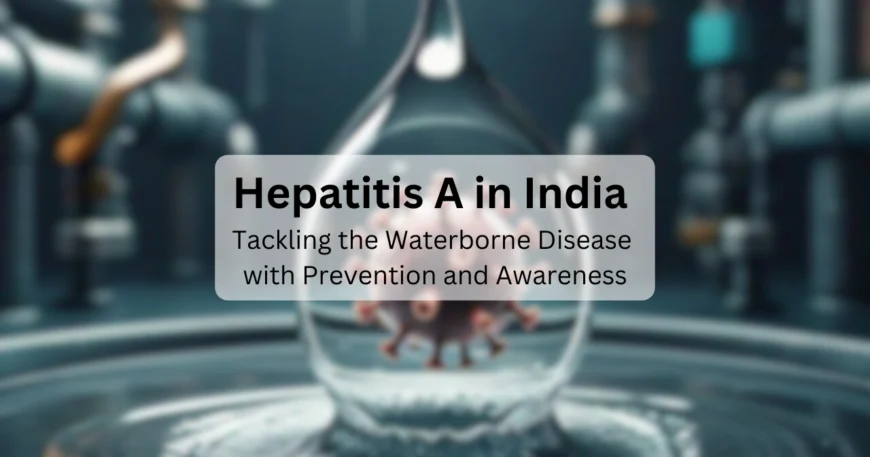In India, where access to clean water remains a challenge for millions, waterborne diseases like Hepatitis A pose a significant public health threat. Hepatitis A, a highly contagious liver infection, spreads primarily through contaminated water and food, making it a critical concern in regions with inadequate sanitation. This blog explores the risks, symptoms, and actionable prevention strategies to combat Hepatitis A in India’s unique context.
What is Hepatitis A?
Hepatitis A is a viral infection caused by the Hepatitis A virus (HAV), which inflames the liver. Unlike Hepatitis B or C, it doesn’t lead to chronic liver disease but can cause debilitating symptoms and occasional outbreaks. The virus thrives in environments with poor hygiene, often spreading through water or food contaminated with fecal matter.
How Does Hepatitis A Spread? The Waterborne Connection
HAV transmission is closely linked to contaminated water sources. In India, factors like:
- Inconsistent access to treated drinking water
- Overflowing sewage during monsoons
- Use of untreated water for irrigation or street food preparation
increase exposure risks. Consuming contaminated water, shellfish from polluted waters, or uncooked vegetables washed in unsafe water can trigger outbreaks.
Why is India Vulnerable to Hepatitis A?
Urban Overcrowding and Sanitation Gaps: Rapid urbanization strains water and sanitation systems, leading to cross-contamination.
Monsoon Challenges: Heavy rains flood sewage systems, mixing wastewater with drinking supplies. States like Kerala and Maharashtra often report seasonal spikes.
Low Vaccination Coverage: Despite affordable vaccines, awareness and accessibility remain limited in rural areas.
Cultural Practices: Street food culture and communal water sources amplify transmission risks.
Symptoms and Diagnosis
HAV symptoms typically appear 2–6 weeks post-exposure and include:
- Jaundice (yellowing of skin/eyes)
- Fatigue, nausea, and abdominal pain
- Dark urine and clay-colored stools
Diagnosis involves blood tests detecting HAV antibodies. Early medical consultation is crucial to manage complications.
Preventing Hepatitis A: Strategies for India
1.Ensure Safe Water Access:
- Boil or use chlorine-treated water for drinking.
- Invest in community water purification systems.
2.Improve Sanitation:
- Promote toilet use over open defecation under Swachh Bharat Abhiyan.
- Regular septic tank maintenance to prevent leaks.
3.Vaccination Drives:
- The Hepatitis A vaccine (2 doses, 6 months apart) is 95% effective. Include it in routine immunization in high-risk states.
3.Public Awareness Campaigns:
- Educate communities on handwashing, food hygiene, and symptom recognition via local languages.
4.Strengthen Healthcare Response:
- Train ASHA workers to identify outbreaks early and distribute ORS to prevent dehydration.
The Role of Wastewater Management and Water Purification in Preventing Hepatitis A
Hepatitis A, a highly contagious liver infection caused by the Hepatitis A virus (HAV), is primarily transmitted through contaminated water and food. In regions with inadequate sanitation and water treatment systems, such as parts of India, the risk of Hepatitis A outbreaks is significantly higher. Effective wastewater management and water purification play a pivotal role in curbing the spread of this waterborne disease. Here’s how these systems contribute to public health and disease prevention.
1. Wastewater Management: Breaking the Chain of Contamination
Wastewater management involves the collection, treatment, and safe disposal of sewage and industrial effluents. Proper management is critical to preventing the contamination of water sources with fecal matter, which is the primary route for HAV transmission.
Key Contributions of Wastewater Management:
- Preventing Water Source Contamination: Untreated sewage often contains harmful pathogens, including HAV. By treating wastewater before it enters rivers, lakes, or groundwater, the risk of contaminating drinking water supplies is minimized.
- Reducing Open Defecation: Inadequate sewage systems force communities to rely on open defecation, which directly pollutes water sources. Improved wastewater infrastructure encourages the use of toilets, reducing fecal contamination.
- Flood Mitigation: During monsoons, overflowing sewage systems can mix with drinking water supplies. Proper drainage and treatment facilities prevent this cross-contamination.
- Community Health Benefits: Effective wastewater management reduces the overall burden of waterborne diseases, including Hepatitis A, cholera, and typhoid, improving public health outcomes.
2. Water Purification: Ensuring Safe Drinking Water
Water purification involves removing contaminants, including pathogens like HAV, from water to make it safe for consumption. In areas where access to clean water is limited, purification systems are essential to prevent disease outbreaks.
Key Contributions of Water Purification:
- Eliminating Pathogens: Purification methods such as chlorination, UV treatment, and filtration effectively kill or remove HAV and other harmful microorganisms from water.
- Providing Access to Safe Water: Community-level water purification plants and household-level solutions like boiling, chlorine tablets, or ceramic filters ensure that even in resource-limited settings, people have access to safe drinking water.
- Supporting Food Safety: Purified water is essential for washing fruits, vegetables, and cooking utensils, reducing the risk of HAV transmission through contaminated food.
- Emergency Response: During natural disasters or outbreaks, portable water purification systems can provide immediate access to clean water, preventing the spread of Hepatitis A.
3. Integrated Approaches for Maximum Impact
To effectively combat Hepatitis A, wastewater management and water purification must work hand-in-hand. Here are some integrated strategies:
- Upgrading Infrastructure: Invest in modern sewage treatment plants and water purification facilities, especially in high-risk urban and rural areas.
- Community Education: Raise awareness about the importance of using treated water and proper sanitation practices to prevent waterborne diseases.
- Policy and Regulation: Enforce stricter regulations on industrial effluents and sewage disposal to protect water sources.
- Public-Private Partnerships: Collaborate with NGOs and private companies to implement affordable and scalable water treatment solutions.
4. The Indian Context: Challenges and Opportunities
India faces unique challenges in wastewater management and water purification, including rapid urbanization, population density, and seasonal flooding. However, initiatives like the Swachh Bharat Mission and Jal Jeevan Mission have made significant strides in improving sanitation and water access. By scaling up these efforts and integrating advanced technologies, India can reduce the burden of Hepatitis A and other waterborne diseases.
Conclusion :
Combating Hepatitis A in India demands a multi-pronged approach: upgrading water infrastructure, expanding vaccination, and fostering behavioral change. By prioritizing clean water access and hygiene education, India can mitigate this preventable disease and safeguard public health.






